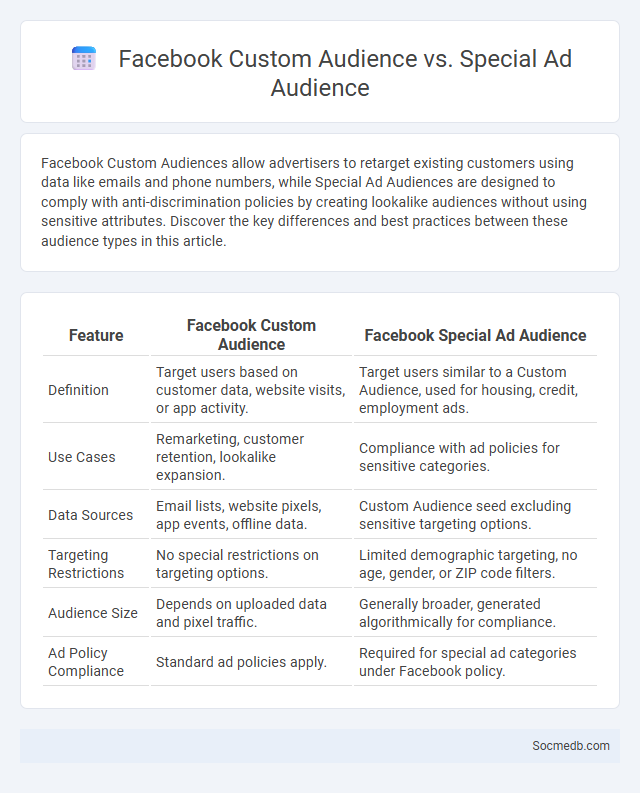
Photo illustration: Facebook Custom Audience vs Special Ad Audience
Facebook Custom Audiences allow advertisers to retarget existing customers using data like emails and phone numbers, while Special Ad Audiences are designed to comply with anti-discrimination policies by creating lookalike audiences without using sensitive attributes. Discover the key differences and best practices between these audience types in this article.
Table of Comparison
| Feature | Facebook Custom Audience | Facebook Special Ad Audience |
|---|---|---|
| Definition | Target users based on customer data, website visits, or app activity. | Target users similar to a Custom Audience, used for housing, credit, employment ads. |
| Use Cases | Remarketing, customer retention, lookalike expansion. | Compliance with ad policies for sensitive categories. |
| Data Sources | Email lists, website pixels, app events, offline data. | Custom Audience seed excluding sensitive targeting options. |
| Targeting Restrictions | No special restrictions on targeting options. | Limited demographic targeting, no age, gender, or ZIP code filters. |
| Audience Size | Depends on uploaded data and pixel traffic. | Generally broader, generated algorithmically for compliance. |
| Ad Policy Compliance | Standard ad policies apply. | Required for special ad categories under Facebook policy. |
Understanding Facebook Custom Audience
Facebook Custom Audience allows you to target specific groups based on existing customer data such as email addresses, phone numbers, or website visitors. This powerful tool helps refine ad delivery by creating highly relevant segments that increase engagement and conversion rates. Leveraging Custom Audiences ensures your marketing efforts are cost-effective and precisely aligned with your audience's behavior and preferences.
What is Special Ad Audience?
Special Ad Audience is a targeting feature on Facebook and Instagram designed to help advertisers reach people with similar behaviors and interests to their existing customers, without using sensitive personal data. This tool refines your ad delivery by leveraging machine learning to find users who match the profiles of those who have interacted positively with your content or made purchases. You can expand your campaign reach effectively while complying with regulations on advertising related to housing, employment, and credit opportunities.
Key Differences: Custom Audience vs Special Ad Audience
Custom Audience allows you to target users based on your existing customer data, such as email lists or website visitors, providing highly specific retargeting opportunities. Special Ad Audience, designed for sensitive ad categories like housing or employment, creates lookalike audiences while restricting certain targeting options to comply with anti-discrimination policies. Understanding these differences enhances your social media ad strategy by aligning audience targeting with compliance and relevance goals.
How Facebook Custom Audiences Work
Facebook Custom Audiences work by allowing you to target specific groups based on data from your customer lists, website traffic, or app activity. This feature uses hashed user information to match your data with Facebook profiles, ensuring precise ad delivery to potential or existing customers. Your ability to segment audiences improves ad relevance and campaign performance by leveraging behavioral and demographic insights.
Compliance and Policy Restrictions
Social media platforms enforce strict compliance and policy restrictions to ensure user safety, prevent misinformation, and protect intellectual property rights. These guidelines regulate content types, advertising practices, and data privacy to align with legal standards such as GDPR and COPPA. Failure to comply with these policies can result in content removal, account suspension, or legal consequences.
Targeting Capabilities Compared
Social media platforms offer advanced targeting capabilities that allow advertisers to reach specific audiences based on demographics, interests, behaviors, and location. You can leverage tools like Facebook Ads Manager or LinkedIn Campaign Manager to create highly tailored campaigns, maximizing engagement and return on investment. These precise targeting options enable businesses to connect with their ideal customers more effectively than traditional advertising methods.
Use Cases for Each Audience Type
Social media platforms cater to diverse audience types with tailored use cases that maximize engagement and value. For businesses, social media drives brand awareness, customer support, and targeted advertising campaigns. Influencers leverage these platforms to build personal brands and monetize content, while everyday users focus on social interaction, entertainment, and staying informed. Understanding Your specific audience type on social media enables more effective content strategies and optimizes overall impact.
Data Source Requirements
Effective social media analysis relies heavily on diverse and high-quality data sources, including user-generated content, interaction metrics, and platform-specific metadata. Accurate insights demand integration of real-time data streams from APIs, public posts, and third-party aggregators while ensuring compliance with privacy regulations and data use policies. Structured data collection must prioritize relevance, authenticity, and granularity to support sentiment analysis, trend identification, and audience segmentation.
Cost and Performance Considerations
Social media marketing demands careful evaluation of cost versus performance metrics such as engagement rates, click-through rates, and conversion rates. You should allocate budget to platforms offering the highest ROI based on audience targeting precision and ad format effectiveness. Monitoring analytics in real time helps optimize spending and improve campaign outcomes.
Choosing the Right Audience for Your Campaign
Identifying and targeting the right audience is crucial for maximizing the impact of your social media campaign. Use demographic data, user interests, and behavior analytics to refine your audience segments effectively. Tailoring content to these specific groups improves engagement rates and boosts overall campaign performance.
 socmedb.com
socmedb.com